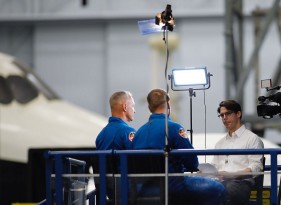This week marks the 50th anniversary of Apollo 11’s moon landing and now, NASA has plans for future missions to the moon and beyond. Reuters built an interactive explainer on space exploration to the moon and delved deep into NASA to lay out future missions. In a Reuters Best: Journalist Spotlight Q&A, Data Visualization Developer Travis Hartman, gives a behind-the-scenes look at how the graphics were developed.
Q: How was this project conceived and why?
A: The Man on the Moon project was a facet of a much larger group of stories we’ve been doing on the burgeoning space race, and 50th anniversary of Apollo 11 was an obvious hook. When we divided up stories at the outset, I was eager to work on this one as I knew there would be a wealth of information, data and images that could lead to a really fun project.
Q: Can you explain the process of developing this project?
A: In initial discussions with my editor, Christine Chan, we didn’t want it to be a simple history lesson, but something that looked forward as much as a nod to the past–so narratively speaking, it’s really kind of an expanded timeline with the pivot point being the moon landing itself. I spent a lot of time in the research phase, reading NASA’s (really gigantic) website to find interesting pieces that I could highlight in the text, and a lot of time programming the three-dimensional moon.
Q: What was the hardest part of the project?
A: Probably figuring out how to plot the landings sites on the moon. In the programming language, it’s just a sphere with a picture of the moon wrapped around it. No built-in mapping coordinates, so I had to reverse engineer how to plot latitude and longitude on what is essentially a ball. In retrospect, it’s a relatively elementary geometry problem, but I’ll admit it had been a long time since I’ve done any geometry of that nature. Needless to say, the internet saved me! Really fun problem to encounter though.
Q: What is your job at Reuters and what do you find most fulfilling about it?
A: My title is Data Visualization Developer, and my favorite part of the job is the learning that takes place as part of the process, and then getting to pass that information along. I really enjoyed finding the human aspects that emerged in the juggernaut that was the space program – like the astronaut height requirement on the Mercury capsule or the corned beef sandwich incident. Additionally, there is a real satisfaction that comes from programming as well – knowing how to fit the pieces together to construct the graphics that can tell stories. Programming is really just a language like English or French, and I enjoy expanding my fluency in this language with every project I work on.
Q: What have been your most rewarding and most difficult experiences as a journalist?
A: I started out in journalism as a photographer and then moved to photo editing for newspapers and magazines. I pivoted to graphics about six years ago, and starting over mid-career has been both the hardest and most rewarding thing I’ve done. I am indebted to my colleagues as I’ve learned far more from them about data literacy and good visual information practice than I ever could have in a school or a class. I feel very lucky to be here.
Q: Can you imagine being anything else? If so, what?
A: Engineering? Maybe carpentry? Work that is creative and solves problems has always appealed to me.




